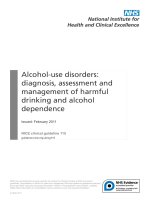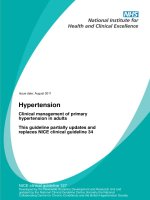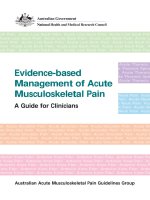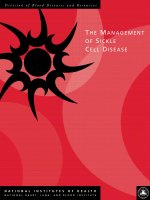hemodynamic management of septic shock
Bạn đang xem bản rút gọn của tài liệu. Xem và tải ngay bản đầy đủ của tài liệu tại đây (797.67 KB, 50 trang )
HEMODYNAMIC
HEMODYNAMIC
MANAGEMENT OF SEPTIC
MANAGEMENT OF SEPTIC
SHOCK
SHOCK
Christian Popa, MD
CPT, MC, USA
Walter Reed Army Medical
Center
Clinical Spectrum of Infection
Clinical Spectrum of Infection
Infection
Sepsis
Severe Sepsis
Septic Shock
Bacteremia
ACCP / SCCM Consensus Definitions of
ACCP / SCCM Consensus Definitions of
SIRS and Allied Disorders
SIRS and Allied Disorders
SIRS
The systemic inflammatory response to a variety of severe clinical insults.
Manifested by 2 or more of the following conditions:
Temperature >38 deg C or <36 deg C
HR >90 beats/min
Respiratory Rate >20 breaths/min or PaCO2 <32 torr (<4.3 kPa)
WBC >12,000 or <4,000 cells/mm3 or >10% bands
SEPSIS
The systemic response to infection. Manifested by the same criteria as
SIRS.
(Critial Care Med 1992 (20):864-874)
ACCP / SCCM Consensus Definitions of
ACCP / SCCM Consensus Definitions of
SIRS and Allied Disorders
SIRS and Allied Disorders
(Critial Care Med 1992 (20):864-874)
SEVERE SEPSIS
Sepsis associated with organ dysfunction, hypoperfusion, or hypotension.
Perfusion abnormalities include but are not limited to:
lactic acidosis
oliguria
mental status
SEPTIC SHOCK
Sepsis with hypotension (SBP<90), despite adequate fluid resuscitation and
perfusion abnormalities as listed for severe sepsis. Patients on inotropic/
vasopressor agents may not be hypotensive.
Incidence / Magnitude of Problem
Incidence / Magnitude of Problem
•
300,000 to 500,000 cases of bacteremia each year in the US with
associated 20-30% mortality.
•
200,000 bouts of septic shock.
•
Sepsis is the leading cause of death in noncoronary intensive care
units.
•
Mortality has changed little over the last 20 years.
•
Incidence of sepsis appears to be increasing.
Reasons Underlying Rising Incidence
Reasons Underlying Rising Incidence
of Sepsis and Continued High
of Sepsis and Continued High
Mortality
Mortality
●
Increased patient age
●
Increased use of cytotoxic/immunosuppresive drug therapy
●
Increased incidence of concomittent medical illness
●
Increased use of invasive devices for diagnosis and therapy
●
Rising incidence of infections due to organisms other than Gram
negative bacteria (Gram + bacteria, fungi, and possibly viruses)
●
Perhabs, the emergence of antibiotic resistant organisms
(Chest 1991 (99): 1000-09).
Individual Host Risk Factors
Individual Host Risk Factors
●
Extremes of age
●
Chronic disease
●
Substance abuse
●
Immunosuppressive therapy
●
Vascular catheterization
●
Prosthetic devices and urinary catheters
●
Tracheal intubation
Bone, RC. The Pathogenesis of Sepsis. Ann Int Med 1991(115): 457-69.
Brun-Bruisson et al. prospectively studied 11,828 consecutive admissions
to 170 adult ICU’s in France over a 2 month period in 1993.
Of these , 64% were medical admissions, while 18%, 14%, and 4% were
scheduled surgery, unscheduled surgery, or nonoperative trauma
respectively.
They found a 9% incidence of clinically suspected and confirmed
sepsis with a 28 day mortality of 56% in patients with severe sepsis.
Only 3 of 4 patients presenting with clinically suspected severe sepsis
had documented infection.
The mortality of the culture negative sepsis subgroup was statistically
similar to the overall group.
JAMA. 1995 ;274: 968-974
Risk Factors for both early (<3days) and secondary (3-28 days) death
Simplified Acute Physiology Score (SAPS) II
# of acute organ system failures
Risk Factors for early death
low arterial pH (<7.33) (P<.001) & shock (P= .03)
Risk Factors for secondary (>3d) death
admission category (unscheduled surgery >> medical > scheduled
surgery > nonoperative trauma (P<.001)
rapidly or ultimately fatal underlying disease (P<.001)
preexisting liver (P=.01) or cardiovascular (P=.02) insufficiency
hypothermia (P=.02)
thrombocytopenia (P=.01)
multiple sources of infection (P=.02)
Brun-Bruisson et al. JAMA, 1995, 274; 12: 968-974
Hemodynamic Abnormalities in Septic
Hemodynamic Abnormalities in Septic
Shock
Shock
●
Prototypic example of distributive shock.
◆
Severe in SVR and generalized blood flow maldistribution develop in
almost all affected patients.
◆
After aggresive volume loading (adequate preload), C.O. normal in 80%
of patients with septic shock.
◆
This is in contrast to cardiogenic, extracardiac obstructive, and
hypovolemic forms of shock which C.O.
◆
Initial in LVEF occuring within 24 hours of onset with associated
increase in both end-systolic and end-diastolic indices.
◆
This pattern of LVEF and LVEDV is characteristic of survivors and is
reversible. Ventricular function/size normalize 7-10 days following onset.
◆
This pattern of dysfunction was extended to the R ventricle in 1990 by
Parker et al. Chest 1990; 97:126-31.
Changes in Cardiac Performance During Acute
Changes in Cardiac Performance During Acute
& Recovery Phases of Septic Shock
& Recovery Phases of Septic Shock
Acute Phase (Hypotension and Reduced SVR)
MAP 40 mm Hg
CVP 2 mm Hg
Cardiac Output 11.25 L/min
Heart Rate 150 beats/min
SVR 270 dyn*sec*cm-5
EF 225ml-50ml =33%
225ml
LVEDV 225 ml LVESV 150 ml
Recovery Phase (Normotension)
LVEDV 125 ml LVESV 50 ml
MAP 75 mm Hg
CVP 5 mm Hg
Cardiac Output 5.25 L/min
HR 70 beats/min
Stroke Volume 75 ml
SVR 1067 dyn*sec*cm-5
EF 125 ml- 50 ml =60%
125 ml
Parillo, JE. Pathogenetic Mechanisms of Septic Shock NEJM 328(20):1471-1477.
Hemodynamic Patterns with
Hemodynamic Patterns with
Prognostic Value
Prognostic Value
●
A lower heart rate at the onset of disease is predictive of survival.
●
Normalization within 24 hours of either tachycardia or elevated
cardiac index is associated with survival. Persistence of hyperdynamic
state increases likelihood of death.
●
A low ejection fraction and ventricular dilatation are also associated
with survival. This perhabs reflects Frank-Starling compensation of
sepsis induced myocardial depression.
Parker et al. Serial Cardiovascular Variables in Survivors and Nonsurvivors; HR as an Early Predictor of Prognosis
Crit Care Med 1987(15): 927-9.
Parrilo, JE. Pathogenetic Mechanisms of Septic Shock, NEJM 1993; 328(20): 1471-77.
Jardin et al. (University of Vienna) prospectively studied 27 surgical
ICU patients in early septic shock.
MAP <60 mmHg.
Age range (21-76), mean 46 years old.
A-line + PAC monitoring.
11 patients (41%) had RV ejection fraction <45 %.
This group required vasoactive/inotropic drugs to achieve &
maintain an adequate perfusion pressure (MAP >60 mm Hg.
Fluid replacement alone, (average 2850 +/- 210 ml crystalloid)
was unsuccessful in keeping MAP >60 mmm Hg at the end of 2
hours in these patients.
Critical Care Med 1990; 18: 1055-1062.
Why Is Ventricular Function Impaired ?
Why Is Ventricular Function Impaired ?
●
High afterload due to pulmonary HTN and aggressive
ventilatory support.
●
Reduced preload due to fluid loss following endothelial cell
injury and inappropriate vasodilation.
●
Coronary perfusion may be reduced by hypotension,
tachycardia and increased myocardial wall tension.
●
Contractility may be impaired by circulating myocardial
depressant substances, diffuse myocardial edema, and B-
receptor dysfunction.
Intensive Care Med 1993; 19: 3-7.
Why Is Ventricular Function Impaired ?
Why Is Ventricular Function Impaired ?
●
Initial hypothesis of coronary hypoperfusion leading to
ischemic myocardial dysfunction was disproven by
Cunnion et al., Circulation 1986; 73: 637-44. They
showed septic patients had coronary blood flows
controls, and similar myocardial lactate levels to patients
with sepsis but no obvious myocardial depression.
●
The presence in the bloodstream of one or more
myocardial depressant substances (MDS) has been
supported by in vitro myocyte preparations.
Myocardial Depressant Substance
Myocardial Depressant Substance
●
affect myocyte contractility in a dose dependent manner
●
water soluble
●
not diffuse through dialysis membrane
●
moderate size molecule at least 10,000 daltons
●
Purified endotoxin, IL-1, Il-2 produced no depression of myocyte
contraction.
●
Endotoxin and IL-2 have produced hemodynamic alterations
similar to septic shock in some human studies.
●
TNF, based on animal models & in vitro myocyte preparation
studies appears to be one of the major mediators of cardiovascular
insufficiency in septic shock.
Chest 1991; 99: 1000-09.
Role of TNF-a in Septic Shock
Role of TNF-a in Septic Shock
●
TNF-a has been proposed as the principal cytokine mediating
septic-shock and sepsis related organ damage. Evidence to this
effect includes:
◆
High circulating TNF-a levels correlate with mortality in endotoxemia.
◆
Passive immunization of some animal models with monoclonal Abs
against TNF-a is protective against mortality/critical organ injury from
lethal bacteremia.
◆
Injection of recombinant TNF-a without LPS leads to pathophysiologic
changes similar to those of bacteremia & MODS.
(Clinical Infectious Diseases 1995(20):143-58.)
Biologic Actions of TNF-a (Cachectin)
Biologic Actions of TNF-a (Cachectin)
●
Hemodynamic
◆
Hyperdynamic circulatory shock
◆
Capillary leak syndrome
◆
Microvascular thrombosis
◆
Inhibition of cardiac myocyte B-adrenergic responsiveness.
●
Microbiologic
◆
PMN activation, degranulation, enhanced O2 radical release.
◆
Neutrophilia, lymphopenia.
◆
Increased vascular permeability of the gut.
●
Immunologic
◆
Induction of hepatic acute phase synthesis
◆
Fever
◆
Promotion of IL-1, IL-2, PAF, IL-6, and eicosanoid production.
◆
Stimulation of B & T lymphocyte proliferation
(Hall, Schmidt, & Wood, Principles of Critical Care, McGrawHill, Inc., New York, 1992.)
Pathogenesis of Septic Shock
Pathogenesis of Septic Shock
LPS
LBP
LPS
ENDOTHELIAL CELL
Bacteria
LPS
LBP
LPS
CD 14
MONOCYTE
soluble CD 14
TNF-A
Journal of Infection 1995; 30: 201-206.
Pathogenesis of Sepsis Mediated Hemodynamic
Pathogenesis of Sepsis Mediated Hemodynamic
Dysfunction
Dysfunction
NIDUS OF INFECTION ORGANISMS EXOGENEOUS TOXINS ENDOGENOUS
MEDIATORS
Pneumonia
Peritonitis
Cellulitis
Abscess
Other Infection Sites
Organism
Structural Component
Exotoxin (TSST-1, Toxin A)
Endotoxin
CYTOKINES
*Interleukin 1,2,….6
*Tumor Necrosis Factor
PLATELET ACT FACTOR
ARACHID ACID METAB
HUMORAL CASCADES
*Complement
*Kinins
*Coagulation
DEATH
HYPOTENSION
MOSF
HYPOTENSION
Severe Decrease SVR
Depressed CO
Multiple Organ System
Failure
RECOVERY
CARDIOVASCULAR
INSUFFICIENCY
MYOCARDIUM
*Depression
*Dilatation
VASCULATURE
*Vasodilation
*Vasoconstriction
*Endothelial Damage
*Maldistribution of flow
Differential Diagnosis of Septic Shock
Differential Diagnosis of Septic Shock
●
Other Nonseptic Causes of Hyperdynamic Shock.
◆
overdosage of drugs with vasodilator properties
◆
Toxic Shock Syndrome
◆
primary/secondary adrenal insufficiency
◆
anaphylactic reactions
◆
severe anemia
◆
severe liver disease
◆
AV fistulas
◆
thyroid storm
◆
severe thiamine deficiency
Differential Diagnosis of Septic Shock
Differential Diagnosis of Septic Shock
●
The forms of shock generally associated with a
vasocostricted peripheral circulation.
◆
hypovolemic shock
◆
cardiogenic shock
◆
obstructed circulation due to embolism or tamponade
Hemodynamic Values in Sepsis
Hemodynamic Values in Sepsis
Syndrome
Syndrome
Parameter Normal Range Change in Sepsis
Heart Rate 72-88 bpm Sinus tahcycardia
MAP 70-105 mm Hg Hypotension <60 mm HG
CVP 2-10 cm H2O Normal, , .
PCWP 8-12 mm Hg Normal, , .
C.O. 4-8 L/min , but often not enough
C.I. 2.5-4 L/min/m2 to compensate for SVR.
SVR 770-1550 dyne/sec/cm5 <600 if no pressors
SVRI 1760-2600 dyne/sec/cm5/m2 <1000 if no pressors
DO2 520-720 mL/min/m2 Normal; may be due to hypoxia
or shunting
VO2 100-180 mL/min/m2 Typically .
Oxygen Delivery
Oxygen Delivery
●
CaO2 = 1.34(gm Hgb/dL)(SpO2) + 0.0031(PaO2)
●
DO2 = C.O. x CaO2
●
VO2 = C.O. x (CaO2 - CvO2)
●
O2ER = (CaO2 - CvO2)/ CaO2
●
Normal range of O2ER is 0.2 to 0.3
●
Critical DO2 in patients undergoing elective CPB was 330 ml/kg/m2
●
Critical DO2 and critical O2ER determined during withdrawal of
therapy in critically ill dying patients were 4.5 and 0.6 ml/kg/min.
◆
Arterial lactate levels increase progressively as O2 delivery
decreases below these critical values.
SUPPLY DEPENDENT O2
SUPPLY DEPENDENT O2
CONSUMPTION
CONSUMPTION
OXYGEN DELIVERY (DO2)
OXYGEN CONSUMPTION (VO2)
NORMAL PHYSIOLOGIC STATE
INCREASED METABOLIC STATE
Critical DO2 Values









